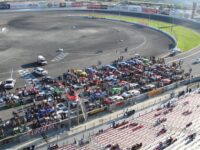 With the closing of Toyota Speedway at Irwindale this past season, it raised a lot of speculation on how a state of the art facility could go from one of the Nation’s most popular short tracks, to one of the biggest mismanaged fiascos since Ontario Motor Speedway closed its gates in 1980.
With the closing of Toyota Speedway at Irwindale this past season, it raised a lot of speculation on how a state of the art facility could go from one of the Nation’s most popular short tracks, to one of the biggest mismanaged fiascos since Ontario Motor Speedway closed its gates in 1980.
It wasn’t long after the track opened, that it became one the most talked about racing facilities from coast to coast, and the excitement the track generated during the early part of its inception was nothing like the disappointment it became in its latter years.
On any given Saturday night, car counts were at all-time high, and the level of competition was some of the best with the fans showing their appreciation by filling the stands week after week.
Irwindale would gain even more National exposure when NASCAR decided in 2003 to hold its annual non-points All-Star Showdown, which brought together both the Camping World East and West series teams to battle for bragging rights on the progressively banked ½ mile speedway.
The race itself was dubbed “The Daytona 500” of short track racing because of the prestige that came with winning this two day racing extravaganza, and the race itself attracted drivers from all over the country including NASCAR’s touring and regional series.
The following year in 2004, the track continued to flex its majesty when Greg Pursley won one of NASCAR’s most prestigious awards. Pursley, who had a full-time job at the track as an instructor at the Performance Race Training School, won the weekly series national championship, an award that had not been accomplished by a California driver in 19 years.
Attendance, as well as car counts began to decline when the drivers and teams begin to voice their opinions on rule changes that were taking place in the middle of the season, along with certain drivers and teams who were being given special treatment.
It became more and more obvious that the vice president and general manager of the track Bob DeFazio, along with competition director Lester Boyer were quickly losing control of the facility when the drivers and fans slowly began to look for other venues to get their racing fix.
During this time, one of the biggest questions surrounding the track was how the track’s CEO Jim Williams could allow the facility to take a turn for the worse, without stepping in and putting a stop to what became obvious throughout the pit area.
More and more things got worse around the track, and during the 2011 season NASCAR sent their officials to find out how the late model division, which happened to be the same division that would crown the national as well as the state champion could allow cars to race without first qualifying.
Defazio knew that in order for either the state or national champion to come from his track, they needed a minimum of 20 cars to start each race, so he allowed both super stocks and the S2 cars to start and park in order to reach the needed car count.
NASCAR approached Defazio and Boyer telling them that all cars had to qualify, in addition to passing tech inspection which included having the same rear spoiler.
All of this embarrassment along with the closing of the track could have been avoided if Defazio would have taken the time to listen and work with all the drivers in all the divisions, instead of playing favorites and trying to monopolize racing to a single track.
Jim Cohan’s Team 211 Entertainment group are on the right path to mending what was broken by a greedy, and unappreciative general manager who only looked out for his own interests while forgetting about the well being of the track.
Cohan knew it would be an uphill battle from day one, and overcoming the challenges ahead could only be achieved by getting the entire racing community involved. “We know that we’re starting out a couple of laps behind,” Cohan said.
“But we also know that we have the support of a great number of former racers, sponsors, and most importantly, our fans who have stood by waiting for this track to come back on line again. We’ll really need everyone’s good will and support, and we’ll be trying very hard to return the favor by running a facility that always puts the customer first.”
Cohan and his management team have been busy working on a schedule as well as formulating a universal rules package with other tracks, in order to accommodate all drivers with the goal of bringing short track racing back to the Southern California area.
With the opening night announcement and full racing schedule only a day away, Cohan secured Los Angeles-based LoanMart as one of the tracks sponsors.
“We met with Colby Estes (LoanMart’s Director of Marketing) two days ago and had an instant rapport,” said Jim Cohan, President of 211 Entertainment Company.
Cohan also added that, “LoanMart told us that they were pleased to be able to associate with Irwindale and that they had been waiting to hear that we were back in the oval track racing business.”
With the pieces slowly but meticulously falling into place, it won’t be long before opening night rolls around and the action and excitement of oval track racing picks up where you left off at the event center, but with a whole different outlook.
Cohan and his 211 Entertainment Company were able to resurrect the 1/8 mile drag strip bringing the Summit Racing Series racing back, along with the street legal program to give teenagers and adults a safe environment to race their cars on.
From all the hype the track has received since announcing it would bring back oval racing with the upcoming schedule only a day away, and the popularity the drag strip has generated since reopening in 2012. Cohan and company look to be on their way to a very successful and highly energetic racing season in 2013.







